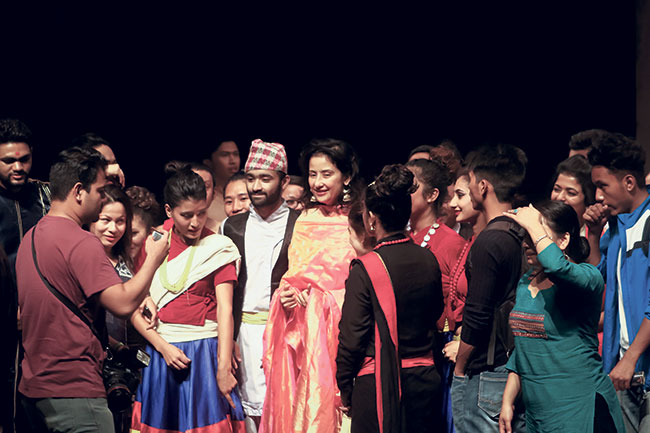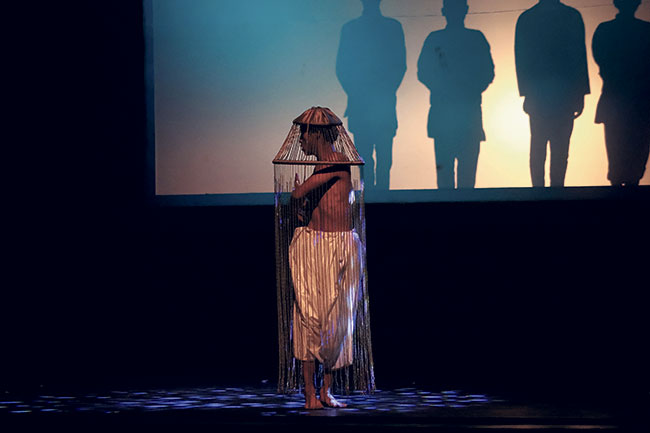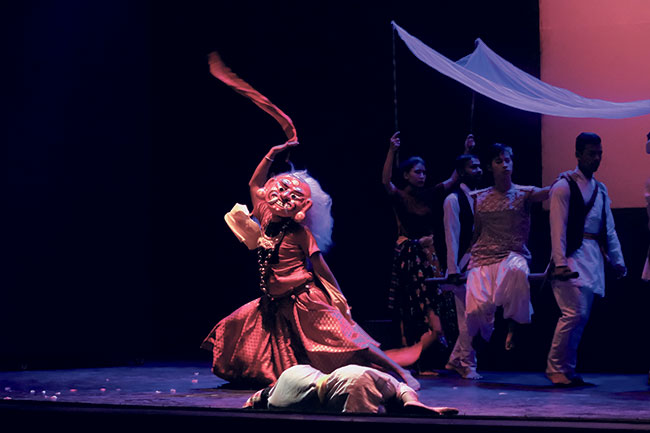KATHMANDU, Sept 19: Art is a form of expression. It’s a medium where one is free to express their story any which way they like. Of all forms of art, theater is one of the most expressive and raw forms of storytelling.
 And anyone who was present at Rastriya Naachghar Theater Hall, Jamal, on Sunday, got to witness a different form of storytelling, where storytelling met with technology. The play ‘Bodhi Chhaya’ depicted the story of Lord Buddha.
And anyone who was present at Rastriya Naachghar Theater Hall, Jamal, on Sunday, got to witness a different form of storytelling, where storytelling met with technology. The play ‘Bodhi Chhaya’ depicted the story of Lord Buddha.
Hardly anyone is unaware of the story of Lord Buddha. The amount of details one knows might differ, but the overall story remains the same. Siddhartha Gautam, also known as Gautam Buddha, is the founder of Buddhism. His teachings have been passed down from generations to generations and are still believed earnestly by the followers.
The story has been told in different occasions till date. Rayshine Travels and Tours and Sushila Arts Academy, in their attempt, showcased Gautam Buddha’s life story and different Nepali cultures in the play using various technological tools such as shadow screens, smokes, cables, attires and several props to enact the story.
The emotions and storyline executed were complemented by different dance styles varying from local Tharu dance, Manjushree dance, Lakhey dance and contemporary dance coupled with an intriguing traditional music as well as sound and light effects to execute the story.
Special effects, videos and thankas were also displayed in three of the LED screens propped above the stage that complemented the play even more as it showed time passing by and other additional details of dialogues or settings being enacted on-stage.
Sharing light and happiness

The play starts from the time when King Suddhodana, leader of the Shakya clan, married Queen Maya Devi somewhere in 565 BC. It moves towards the time where the royal couple longed for a child and the time when Sidhhartha was born to them. Commoners can be seen dancing around the palace (the stage) in joy during each of the events.
The story gradually shifts to the time of Prince Siddhartha’s childhood, how he grew up in the palace and different instances of his character. He one day grows the desire to go beyond the palace and roams around the city to observe his people and how they live. He sees the crippled/sick, old people and death, and starts pondering about the meaning of life.
 He soon wants to leave the ‘prison of pleasure’ and seeks ‘calm, peaceful and dignified life’ beyond the palace. Attachments, love and family bind him inside the palace for years. Nevertheless, he leaves the palace and starts his journey to attain enlightenment. The play ends with Buddha’s teachings and his attainment of nirvana.
He soon wants to leave the ‘prison of pleasure’ and seeks ‘calm, peaceful and dignified life’ beyond the palace. Attachments, love and family bind him inside the palace for years. Nevertheless, he leaves the palace and starts his journey to attain enlightenment. The play ends with Buddha’s teachings and his attainment of nirvana.
In Bodhi Chhaya, the actors were also not limited to the stage. About 90 percent of the play was enacted on-stage where they used every corner. But few of the character also used the seating area of the hall for entries. The characters had retained their poise from the beginning and danced their way to the stage.
The play is one hour and 15 minutes long. It is written and directed by Kavita Srinivasan and was enacted by 40 actors.
The play was jointly inaugurated by Vice-Finance Minister Udaya Shamser Rana, Ambassador of People's Republic of China to Nepal Yu Hong and Bollywood actress and UNFDPA Ambassador Goodwill Ambassador to Nepal Manisha Koirala.
On the occasion, Senior Cultural Advisor to Bodhi Chhaaya production and UNICEF Goodwill Ambassador to Nepal Ani Choying Drolma chanted the prayer ‘Buddham Sharanam Gachchami’—a song where one seeks refuge, enlightenment from Buddha’s teaching—as a start to the auspicious initiative. The audience joined Ani and sang along in one tone before the curtains were finally raised.
Nepal Fine Arts Chancellor Ragini Upadhaya Grela, President of Nepal Cultural Corporation Rasyriya Nachghar Rajesh Thapa and Annapurna Hotel Owner Shreejana Rana were some of other special guests that attended the event.
To witness the commencement of such unique intuitive, people from various walks of life, belonging to different religions, different nationalities and professions had gathered at Naachghar. Many were aware of Buddha’s story, while some had heard the story for the first time.
“I was not quite aware of the story; I have only heard second-hand stories from friends and family. It is also my first time watching a play in a theater and I hope to watch more of these in the future. All actors have held their characters well, the poise and the ease with what they have enacted the whole show is commendable,” said Shankuntala Khetan, a homemaker sitting in the audience.
Adding her own perspective to the play, Khetan said, “What differentiates Hinduism and Buddhism is that we Hindus worship idols whereas Buddhism promotes ideals, beliefs and meditation for self-awareness. Other than that both the religions have no difference in core ideology and beliefs,” added.
 Singer and advisor Ani also appreciated the artists’ effort on-stage saying, “It’s a great initiative where upcoming artists and art can flourish. It might be a great way to encourage others as well. People from neighboring countries and of different religions gathered here today to witness the play in hope to learn Buddha’s teachings. The government and people from all walks of life need to support this type of art more.”
Singer and advisor Ani also appreciated the artists’ effort on-stage saying, “It’s a great initiative where upcoming artists and art can flourish. It might be a great way to encourage others as well. People from neighboring countries and of different religions gathered here today to witness the play in hope to learn Buddha’s teachings. The government and people from all walks of life need to support this type of art more.”
The play was narrated and enacted in English. So one, who is not fluent in English, might have trouble understanding. Nevertheless, one can still thoroughly enjoy the narration and its dramatic execution.
The show is supported by the Ministry of Tourism, Culture and Civil Aviation and Nepal Tourism Board. The theater put together under Bodhi Chhaaya’s production is scheduled to run daily at 6 pm for the next five years at Rastriya Naachghar.






































